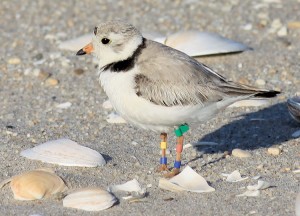By Joe Reynolds
With the arrival of spring comes the sight of piping plovers to the Jersey Shore. This small sand-colored shorebird has been signaling the coming of spring for centuries. Yet with only around a hundred breeding pairs, life is not easy.
Many challenges exist to increase the population. Once plovers arrive, their success at raising a family depends on whether they’ll be able to run a gauntlet of storms, flood tides, and prowling predators from hungry raccoons and foxes, to gulls and crows.
Garbage and human-provided food left on a beach are always trouble. It attracts hungry predators and forces piping plovers to abandon nests. Trashy beaches have resulted in unnaturally high predation pressure.
In addition, as coastal development has increased, wide-open beach habitat for nesting plovers has decreased. Where beaches are protected, people often have to share space from March to September with nesting birds. Areas become closed off, which may frustrate some beachgoers and fishermen. For example, at Sandy Hook in 2009, park rangers were searching for someone who removed two incubating piping plover eggs from a nest and damaged fencing that protected shorebirds.
Piping plovers, however, are not giving up. Better protection and policing of beach habitat seems to be working.
According to Todd Pover, Beach Nesting project manager for the Conserve Wildlife Foundation of New Jersey, the population of breeding pairs has increased 17 percent to 108 pairs in 2015. The statewide fledgling rate was 1.29 per pair, one of the highest statewide levels since federal listing as a threatened species in 1986.
The best local news is that northern Monmouth County, as a region, continued to account for the largest percentage of pairs in the state (55 pairs or 51 percent), with Sandy Hook NRA accounting for most of those pairs. In addition, the percentage of pairs that successfully hatched at least one egg in the state was high at 79 percent, well above the average since federal listing.
Despite increases, the Jersey Shore piping plover population still exists below the long-term average of 118 pairs and remains endangered. More work needs to be done; and this includes understanding where the bird spends the winter.

We used to think piping plovers wintered from South Carolina to Mexico, and northern Cuba. Recently, the U.S. Fish and Wildlife Service, the National Audubon Society and other government and non-government organizations were able to establish certain areas in the Bahamas as important wintering areas with large populations. Now the need exists to fully protect those sites in the Bahamas from coastal development for plovers to feed.
Want to help in the recovery of piping plovers? Please keep beaches clean, protect coastal dune habitat, and better understand how the destruction of habitat leads to endangered and threatened species.
Joe Reynolds is a local naturalist and birder. He will be giving a free talk about the plight of piping plovers on Thursday, March 31 at the Bayshore Waterfront Park Activity Center in Port Monmouth, Middletown Township starting at 7 p.m.














